For a printable version of newsletter click here.
IN THE SCHREBERGARTEN
Last night, back in Frankfurt. In a hotel close to the railroad station for catching an early-bird train to the airport. What a two weeks it’s been for Lena Lentz Hardt of Lentz Spelt Farms on the Columbia Plateau, tracing her progenitors’ stories from 700 AD onward, in Dörfer (villages with closed-system farmlands) by monasteries and their abbots, in Dörfer by castles and their knights, surviving Black Death and witch hunt era and the Revolution of 1525, and suffering the beginnings of the territorial state.
Next up, the Russia years.
Just one more German angle, though: Lentz can’t help but wonder who she’d be if her family hadn’t emigrated.
Not that she’s acquired an altogether positive impression of 2014 Germany. To put it mildly.
The territorial state that had developed after Middle Ages feudalism turned into the absolute state in the mid-1800s, nationalism rising: not only in Germany but across Europe people came to identify themselves as nationals of countries, empires. It’s only now that we can really speak of a Germany, a Romania, etc.
The German Empire began with Kaiser Wilhelm I in 1871. There was a great rallying of the national spirit out of sheer competitiveness. This can be explained as a push against a zeitgeist depressed by the fact that, all around Germany, kingdoms had raised themselves to world powers whereas poor Germany was rather second-tier, wasn’t it. Other nations didn’t mind that status, the Poles, the Czechs, the Romanians, no, proud though they were of their nation they didn’t strive for front and center on the world stage.
Why hadn’t German kingdoms grown into world powers? First, way back in the Middle Ages their Holy Roman Kaiser didn’t reign from a central city but rode from Pfalz to Pfalz where his castles stood. That’s why Germany has no world city, no Paris, no London, no Amsterdam. Second, and more to the point, is that world powers arose by colonization, during which period the Germans were busy bashing one-another’s heads in over religions, plural.
It was Kaiser Wilhelm II who was most determined to put Germany on top of the world. He built up a huge navy, and had schools educate the young men in such manner that, when the time came, they would be enthusiastic cannon-fodder in those early days of industrialized warfare. The 1914 assassination of Archduke Franz Ferdinand of Austria, in Serbia, the Kaiser took as pretext to go to war by invading Belgium on the way to conquer France, thereby igniting World War One. Verdun and all that.
The outcome after four long killing years was a humiliated Germany in defeat.
A mere four years after war’s end, Adolf Hitler, an Austrian-born German, became the leader of the Nationalsozialistische Arbeiterpartei, Nazi Party for short. This occurred in Munich, from the get-go the Nazis’ stronghold.
Last night, back in Frankfurt. In a hotel close to the railroad station for catching an early-bird train to the airport. What a two weeks it’s been for Lena Lentz Hardt of Lentz Spelt Farms on the Columbia Plateau, tracing her progenitors’ stories from 700 AD onward, in Dörfer (villages with closed-system farmlands) by monasteries and their abbots, in Dörfer by castles and their knights, surviving Black Death and witch hunt era and the Revolution of 1525, and suffering the beginnings of the territorial state.
Next up, the Russia years.
Just one more German angle, though: Lentz can’t help but wonder who she’d be if her family hadn’t emigrated.
Not that she’s acquired an altogether positive impression of 2014 Germany. To put it mildly.
The territorial state that had developed after Middle Ages feudalism turned into the absolute state in the mid-1800s, nationalism rising: not only in Germany but across Europe people came to identify themselves as nationals of countries, empires. It’s only now that we can really speak of a Germany, a Romania, etc.
The German Empire began with Kaiser Wilhelm I in 1871. There was a great rallying of the national spirit out of sheer competitiveness. This can be explained as a push against a zeitgeist depressed by the fact that, all around Germany, kingdoms had raised themselves to world powers whereas poor Germany was rather second-tier, wasn’t it. Other nations didn’t mind that status, the Poles, the Czechs, the Romanians, no, proud though they were of their nation they didn’t strive for front and center on the world stage.
Why hadn’t German kingdoms grown into world powers? First, way back in the Middle Ages their Holy Roman Kaiser didn’t reign from a central city but rode from Pfalz to Pfalz where his castles stood. That’s why Germany has no world city, no Paris, no London, no Amsterdam. Second, and more to the point, is that world powers arose by colonization, during which period the Germans were busy bashing one-another’s heads in over religions, plural.
It was Kaiser Wilhelm II who was most determined to put Germany on top of the world. He built up a huge navy, and had schools educate the young men in such manner that, when the time came, they would be enthusiastic cannon-fodder in those early days of industrialized warfare. The 1914 assassination of Archduke Franz Ferdinand of Austria, in Serbia, the Kaiser took as pretext to go to war by invading Belgium on the way to conquer France, thereby igniting World War One. Verdun and all that.
The outcome after four long killing years was a humiliated Germany in defeat.
A mere four years after war’s end, Adolf Hitler, an Austrian-born German, became the leader of the Nationalsozialistische Arbeiterpartei, Nazi Party for short. This occurred in Munich, from the get-go the Nazis’ stronghold.
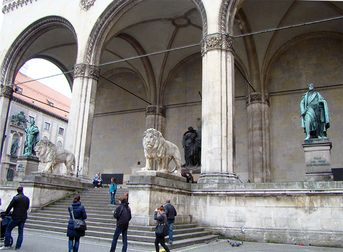
By the mid-1930s, every German still in Germany was a Nazi. Not that everyone was in the Nazi party, but the Germans’ strict adherence to Gehorsam über Alles – total obedience! – amounted to complicity.
And after World War Two?
With the exception of a few top level men at the Nuremberg Trials, and prisoners of war in the Allied countries, everyone got off scot-free. As for the big industrialists who’d played such a crucial role in the holocaust and the myriad of war crimes, a few of them received prison sentences at Nuremberg but were released very prematurely, their pre-war wealth restored to them. Blame Washington: just as the Russians were determined to showcase communism in East Germany, so the American administration was set on creating a model capitalism in West Germany, and for that those industrialist criminals were deemed indispensable.
But what of German courts? Lawrence Douglas, an American journalist covering Ivan Demjanjuk’s trial for war crimes, 2009 in Munich, explains that the post-war West German justice system used an insidious legal tactic to avoid sending any Nazis to prison: “In effect, the German penal code made the Holocaust, insofar as it represented murder, the work of only three men – Hitler, Himmler, and Heydrich – and transformed every death-camp functionary into a mere accessory... In judging those who operated the machinery of death, postwar German courts actually employed SS (Schutzstaffel, Hitler’s paramilitary ‘protection squadron’) standards of legality, designating as perpetrators only those individuals who could have been condemned by the SS’s own tribunals.”
Talk to a West German growing up in the 1950s, and you’ll hear of a farcical atmosphere throughout the country as nobody mentioned the Third Reich, as though it had never happened. All those crimes and war crimes, nobody could remember. And although there was no more Hitler cult to speak of, the teachers in the schools, the police in the streets, the clerics in the churches etc. were all still Nazis at heart as life went on.
And today? That depends on whom you ask. The typical German gets offended if you suggest that 2014 Germany is still Nazi-Land. “Oh, come on, all that happened so very long ago.”
And after World War Two?
With the exception of a few top level men at the Nuremberg Trials, and prisoners of war in the Allied countries, everyone got off scot-free. As for the big industrialists who’d played such a crucial role in the holocaust and the myriad of war crimes, a few of them received prison sentences at Nuremberg but were released very prematurely, their pre-war wealth restored to them. Blame Washington: just as the Russians were determined to showcase communism in East Germany, so the American administration was set on creating a model capitalism in West Germany, and for that those industrialist criminals were deemed indispensable.
But what of German courts? Lawrence Douglas, an American journalist covering Ivan Demjanjuk’s trial for war crimes, 2009 in Munich, explains that the post-war West German justice system used an insidious legal tactic to avoid sending any Nazis to prison: “In effect, the German penal code made the Holocaust, insofar as it represented murder, the work of only three men – Hitler, Himmler, and Heydrich – and transformed every death-camp functionary into a mere accessory... In judging those who operated the machinery of death, postwar German courts actually employed SS (Schutzstaffel, Hitler’s paramilitary ‘protection squadron’) standards of legality, designating as perpetrators only those individuals who could have been condemned by the SS’s own tribunals.”
Talk to a West German growing up in the 1950s, and you’ll hear of a farcical atmosphere throughout the country as nobody mentioned the Third Reich, as though it had never happened. All those crimes and war crimes, nobody could remember. And although there was no more Hitler cult to speak of, the teachers in the schools, the police in the streets, the clerics in the churches etc. were all still Nazis at heart as life went on.
And today? That depends on whom you ask. The typical German gets offended if you suggest that 2014 Germany is still Nazi-Land. “Oh, come on, all that happened so very long ago.”
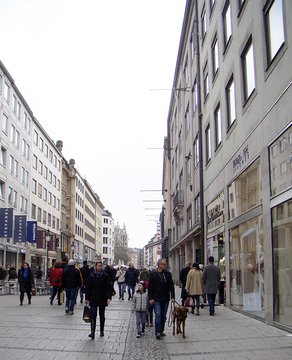
Elsewhere in Europe, well, some people see Germans positively, many others rather not. One thing that’s held against Germany is that after the Berlin Wall had come down in 1989, the West German government just took over East Germany – no referendum, nothing –, an aggressiveness eerily reminiscent of Hitler’s acquisition of Austria.
Then there is the fact that Germany has been involved in almost continuous warfare since World War Two, by proxy, in that they heartily support and publicly cheer on the American military endeavors (with the exception of the Iraq War). A late example is an installation in Germany that directs American drones bombing Pakistan.
And of course the Bundeswehr military is getting built up, albeit slowly. Weapon sales to other countries are nefariously routine. And now they also want to build drones.
Few if any Germans see the European Union as a community of 28 equal nations. Why should they?, Germany’s strong economy makes it the EU’s powerhouse. Every day their media tells them that this makes them better than the other EU members. German youths grow up with that constant refrain.
Even more troubling are political pressures emanating from Berlin. Almost daily chancellor Angela Merkel speaks into microphones announcing that, “Europe needs leadership and Germany (sometimes: ‘France and Germany’) will be the leader(s).”
Since the beginning of the financial crisis, Germany, via the European Central Bank in Frankfurt, has dictated to Mediterranean nations how they must run their states, the enforced austerity programs causing huge unemployment such as over 50 percent of Spain’s under-30s. It’s no wonder that in Greece, Angela Merkel is depicted wearing a brown shirt with Hitler’s swastika. The German finance minister who thinks up all those wonderful schemes to control the rest of the Euro Zone, Wolfgang Schäuble, is a close relation of Hermann Göring of Nuremberg Trials fame.
But wait, do we discern a crosswind? In January 2015 Greece elected a government left of center who’s demanding reparations from the Germans. And calling on other European nations to do the same. Finally.
According to a report in the British press: “The Nazi regime ended up bleeding Greece dry. The (forced) loan to the Third Reich was for 476 million Reichsmarks, which was valued at $8.25 billion in a 2012 German Bundestag lower house of parliament report.”
Are we surprised that the Germans refuse to pay (as of this writing).
Then there is the fact that Germany has been involved in almost continuous warfare since World War Two, by proxy, in that they heartily support and publicly cheer on the American military endeavors (with the exception of the Iraq War). A late example is an installation in Germany that directs American drones bombing Pakistan.
And of course the Bundeswehr military is getting built up, albeit slowly. Weapon sales to other countries are nefariously routine. And now they also want to build drones.
Few if any Germans see the European Union as a community of 28 equal nations. Why should they?, Germany’s strong economy makes it the EU’s powerhouse. Every day their media tells them that this makes them better than the other EU members. German youths grow up with that constant refrain.
Even more troubling are political pressures emanating from Berlin. Almost daily chancellor Angela Merkel speaks into microphones announcing that, “Europe needs leadership and Germany (sometimes: ‘France and Germany’) will be the leader(s).”
Since the beginning of the financial crisis, Germany, via the European Central Bank in Frankfurt, has dictated to Mediterranean nations how they must run their states, the enforced austerity programs causing huge unemployment such as over 50 percent of Spain’s under-30s. It’s no wonder that in Greece, Angela Merkel is depicted wearing a brown shirt with Hitler’s swastika. The German finance minister who thinks up all those wonderful schemes to control the rest of the Euro Zone, Wolfgang Schäuble, is a close relation of Hermann Göring of Nuremberg Trials fame.
But wait, do we discern a crosswind? In January 2015 Greece elected a government left of center who’s demanding reparations from the Germans. And calling on other European nations to do the same. Finally.
According to a report in the British press: “The Nazi regime ended up bleeding Greece dry. The (forced) loan to the Third Reich was for 476 million Reichsmarks, which was valued at $8.25 billion in a 2012 German Bundestag lower house of parliament report.”
Are we surprised that the Germans refuse to pay (as of this writing).
*****
So what was it like for Russian-German American Lentz to be among German Germans?
Let’s start with the Büdingen Castle tour guide, Christa Hollnagel in a bright red flowing coat. She has the details of every room and of every count and prince who ever lived here.
The castle is unique: due to the relatively weak financial constitution of the Isenburg princes, they didn’t remove an older castle component when they built in a new style, instead they left the old and simply added another story. Thus this castle exhibits Romanesque architecture with its rounded arches, topped by Gothic pointed arches that, yet another story up, yield to the horizontal flair of Renaissance architecture – “the Renaissance, oh, the Renaissance!” Inside the castle we see the interiors of each of the epochs.
Let’s start with the Büdingen Castle tour guide, Christa Hollnagel in a bright red flowing coat. She has the details of every room and of every count and prince who ever lived here.
The castle is unique: due to the relatively weak financial constitution of the Isenburg princes, they didn’t remove an older castle component when they built in a new style, instead they left the old and simply added another story. Thus this castle exhibits Romanesque architecture with its rounded arches, topped by Gothic pointed arches that, yet another story up, yield to the horizontal flair of Renaissance architecture – “the Renaissance, oh, the Renaissance!” Inside the castle we see the interiors of each of the epochs.
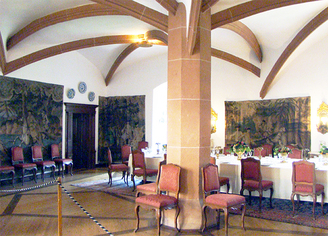
In addition to her deep knowledge, Hollnagel continuously professes great awe of all the aristocrats, which seems excessive to Lentz, especially in view of the fact that we’d told Hollnagel that Lentz is here to connect with her emigrant farmer roots. Hollnagel appears to be completely oblivious to how a descendant of serfs who were suppressed and exploited by all those princes, might be feeling about her constant groveling before anyone with a title, in any given era.
Still, a good tour.
Had Hollnagel stopped right there.
But, no, before she lets us go she lectures us on the Germans in general, in the most misshapen notes. The world owes Germany so much!, she proclaims. Germany has produced the best writers, best painters, best thinkers, best musicians in all the world! (Huh? Schiller, Dürer, Lessing, who? Beethoven, yes, we’ve heard of him, alongside Tchaikovsky, Berlioz, Verdi, Bob Dylan.)
Listen to how the German language forms those long, long words, this makes it the best language in the world, and the most romantic (check the root of “romantic,” it’s a very far cry from germanic). As a matter of fact, Germans are the most romantic people in the world, Gefühl, oh the “emotion” in German hearts!
It’s hard to take, Hollnagel’s Deutschland-über-Alles diatribe.
And it get’s worse: it’s all the Frenchmen's fault that Germany never became a world leader (a ludicrously false statement); the Arabs are inferior because they never experienced a Renaissance like the Germans did (not worth commenting on, is it). And on and on, not only hubris but ugly hubris.
Are you in shock? We were, aware that this is precisely the stuff they taught their children in school before Hitler, under Hitler, and they’re teaching it to them now.
Still, a good tour.
Had Hollnagel stopped right there.
But, no, before she lets us go she lectures us on the Germans in general, in the most misshapen notes. The world owes Germany so much!, she proclaims. Germany has produced the best writers, best painters, best thinkers, best musicians in all the world! (Huh? Schiller, Dürer, Lessing, who? Beethoven, yes, we’ve heard of him, alongside Tchaikovsky, Berlioz, Verdi, Bob Dylan.)
Listen to how the German language forms those long, long words, this makes it the best language in the world, and the most romantic (check the root of “romantic,” it’s a very far cry from germanic). As a matter of fact, Germans are the most romantic people in the world, Gefühl, oh the “emotion” in German hearts!
It’s hard to take, Hollnagel’s Deutschland-über-Alles diatribe.
And it get’s worse: it’s all the Frenchmen's fault that Germany never became a world leader (a ludicrously false statement); the Arabs are inferior because they never experienced a Renaissance like the Germans did (not worth commenting on, is it). And on and on, not only hubris but ugly hubris.
Are you in shock? We were, aware that this is precisely the stuff they taught their children in school before Hitler, under Hitler, and they’re teaching it to them now.
To be fair, America has its own problems of we’re-better-than-anyone-else arrogance within the confines of its imperialism. And Britain certainly is gung-ho to go along with America’s wars.
The difference is that hereabouts the concepts of civil disobedience are embedded in the culture, from the Boston Tea Party to Henry David Thoreau to Mark Twain to Martin Luther King. Conversely, Germans are so gehorsam, it can be 4 a.m., not a car in sight, yet they will not cross the street against a red light. Really.
Germans are a people so conformed, you start wondering if maybe they’re clones. There is no color to their society: if political correctness rubs many wrong in America, Germany has taken it to the extreme. Even when they party – as they did when Lentz visited, it was Fastnacht, Mardi Gras – they come across, well, stilted. Lentz asks to change the channel when TV broadcasts their Fastnacht shows, it’s just too weird.
The difference is that hereabouts the concepts of civil disobedience are embedded in the culture, from the Boston Tea Party to Henry David Thoreau to Mark Twain to Martin Luther King. Conversely, Germans are so gehorsam, it can be 4 a.m., not a car in sight, yet they will not cross the street against a red light. Really.
Germans are a people so conformed, you start wondering if maybe they’re clones. There is no color to their society: if political correctness rubs many wrong in America, Germany has taken it to the extreme. Even when they party – as they did when Lentz visited, it was Fastnacht, Mardi Gras – they come across, well, stilted. Lentz asks to change the channel when TV broadcasts their Fastnacht shows, it’s just too weird.
*****
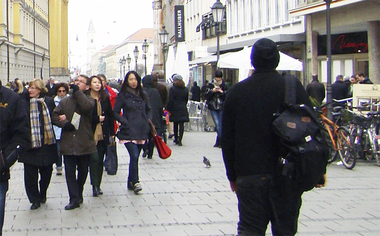
Germans in general are not a friendly people. It’s not only toward foreigners that they wear sour faces, Lentz observed: among themselves, too, they don’t converse, on the train for instance, unless they belong to the same club, school, family. We suppose you could see their society as a million cliques.
“On the street they don’t look you in the eye,” Lentz remarks. “What’s wrong with them?”
Waiters and store clerks were friendly. And Lentz’s German contacts surely went out of their way to offer friendship. So it’s not all bad.
“On the street they don’t look you in the eye,” Lentz remarks. “What’s wrong with them?”
Waiters and store clerks were friendly. And Lentz’s German contacts surely went out of their way to offer friendship. So it’s not all bad.
*****
Let’s end on a positive note. By a Laube in a Schrebergarten.
Schrebergärten sprawl all over Germany. Every town and city spreads green doormats before the traveller on the rocketing train, for a split second you see folks busy with rake and spade and garden hose in a green flash that ends in concrete-by-the-square-kilometer. That green flash, those are Schrebergärten. Germany’s a nation of renters, the Schrebergärten a spatial and cultural relief from their urban rental existence.
Schrebergärten: green space divvied up into a multitude of small parcels of gardens, each with a Laube, literally “bower,” a garden hut. The land belongs to, or is leased by, a club. The Schreber in Schrebergarten refers to Moritz Schreber, an 1800s pedagogue.
The Schrebergarten we get to know is Jürgen Grau’s in the Freimann quarter of Munich. The club here is the Freimann Chapter of the Bahn und Landwirtschaftsverein – “Railroad and Agriculture Association.” Not far from the River Isar along which the Englischer Garten park winds for miles, the Schrebergarten grounds here consist of 227 garden parcels, most of them 50 feet by 50 feet.
Schrebergärten sprawl all over Germany. Every town and city spreads green doormats before the traveller on the rocketing train, for a split second you see folks busy with rake and spade and garden hose in a green flash that ends in concrete-by-the-square-kilometer. That green flash, those are Schrebergärten. Germany’s a nation of renters, the Schrebergärten a spatial and cultural relief from their urban rental existence.
Schrebergärten: green space divvied up into a multitude of small parcels of gardens, each with a Laube, literally “bower,” a garden hut. The land belongs to, or is leased by, a club. The Schreber in Schrebergarten refers to Moritz Schreber, an 1800s pedagogue.
The Schrebergarten we get to know is Jürgen Grau’s in the Freimann quarter of Munich. The club here is the Freimann Chapter of the Bahn und Landwirtschaftsverein – “Railroad and Agriculture Association.” Not far from the River Isar along which the Englischer Garten park winds for miles, the Schrebergarten grounds here consist of 227 garden parcels, most of them 50 feet by 50 feet.
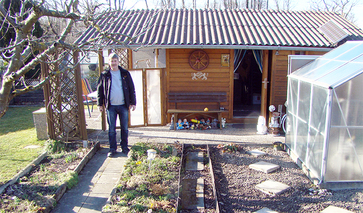
We follow Grau on the walkway flanked by gardens stacked next to one another very uniformly in overall appearance but highly individualistic in the details. At his garden Grau proudly opens the gate for us, it’s a gate like no other, he made it himself of stainless steel – he’s welder and metal worker by occupation. Inside his garden a short flowerbed-lined path with a plot for vegetables on one side, a small lawn with short apple and plum trees on the other. Along the fence more flowers and five kinds of berry bushes and grape vines. A tiny greenhouse for raising starts.
Grau bids us sit on the porch of the Laube. He gets us an Augustiner, Munich’s most famous beer. A mere 10-minute walk from the Graus’ apartment, his Schrebergarten claims most of Grau’s free time during the warm seasons, he comes here almost daily, he tells us, to exercise his green thumb, and also for outdoor relaxation. Indeed it is a fine little plot – once you get used to the idea of 227 small-scale gardeners next to one another within the Munich metropolitan region of 5 1/2 million.
Stretch out your legs comfortably and watch Grau do his Grillen, German-style barbecue of meats bought already seasoned. Grau’s wife Gabi will join us shortly, bringing a bowl of salad. Everyone knows that conversation flows differently outdoors than indoors, more freely, and Lentz enjoys this setting that’s so typical of Germany.
Grau bids us sit on the porch of the Laube. He gets us an Augustiner, Munich’s most famous beer. A mere 10-minute walk from the Graus’ apartment, his Schrebergarten claims most of Grau’s free time during the warm seasons, he comes here almost daily, he tells us, to exercise his green thumb, and also for outdoor relaxation. Indeed it is a fine little plot – once you get used to the idea of 227 small-scale gardeners next to one another within the Munich metropolitan region of 5 1/2 million.
Stretch out your legs comfortably and watch Grau do his Grillen, German-style barbecue of meats bought already seasoned. Grau’s wife Gabi will join us shortly, bringing a bowl of salad. Everyone knows that conversation flows differently outdoors than indoors, more freely, and Lentz enjoys this setting that’s so typical of Germany.
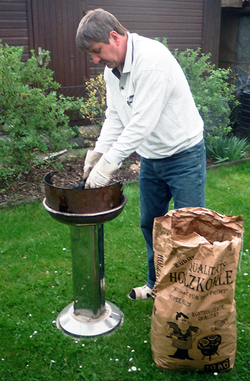
Neighboring countries also have these type of garden allotments, but Germany has by the far the most: over 15,000 clubs lease gardens where an estimated 5 million people tend vegetable beds, pick berries, and enjoy their own 200 to 400 square meters of outdoors any way they can, naturally within the club’s rules. It wouldn’t be German without long lists of rules, would it.
Of course, among the general populace some make fun of Schrebergärtner, sometimes also called Kleingärtner, “small-gardeners.” Thus we arrive at Nanologie, the science of nanus, Latin for “dwarf.” You guessed it, we’re talking garden gnomes, the Gartenzwerge. Are they cult or are they what Germans call Kitsch, funk? In 1980 the Swiss professor Fritz Friedmann founded The International Union for the Protection of Garden Gnomes. While he was at it Friedman defined the Gartenzwerg: he – always a male – measures a maximum 69 centimeters, sprouts a beard and wears a pointed hat.
We’re not making this up: Gartenzwerge have quite a history of court appearances. Neighbors get offended and sue. Remember this is Germany.
Of course, among the general populace some make fun of Schrebergärtner, sometimes also called Kleingärtner, “small-gardeners.” Thus we arrive at Nanologie, the science of nanus, Latin for “dwarf.” You guessed it, we’re talking garden gnomes, the Gartenzwerge. Are they cult or are they what Germans call Kitsch, funk? In 1980 the Swiss professor Fritz Friedmann founded The International Union for the Protection of Garden Gnomes. While he was at it Friedman defined the Gartenzwerg: he – always a male – measures a maximum 69 centimeters, sprouts a beard and wears a pointed hat.
We’re not making this up: Gartenzwerge have quite a history of court appearances. Neighbors get offended and sue. Remember this is Germany.
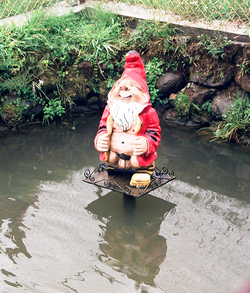 Gartenzwerg in Romania
Gartenzwerg in Romania Time was when actual humans suffering from dwarfism were part of the aristocrats’ courts; from the mid-1500s on, jester Hofzwerge entertained the high and mighty. Another origin of the Gartenzwerg is found in much Germanic folklore wherein mythical gnomes are frequently associated with prospectors’ and miners’ luck. The magical sword of Siegfried was forged by gnomes.
Alas, by the 1990s an organization called The Front for Freeing the Gnomes became active, opposing “the exploitation of garden gnomes by diabolical Kleingärtner.” The Front demanded an end to “the internment of gnomes in gardens.”
We do see gnomes in Grau’s garden; his wife has a soft spot for ceramic garden ornaments, Grau confides. “What can I do?,” he reflects. “First you agree to one Gartenzwerg, then they multiply.”
To sum up: Schrebergärten are perceived as Paradies mit Laube on one end of the spectrum, by folks such as Stefan Leppert who wrote the book by that title, “Paradise with Garden Hut.” He reports on Bertram Weisshaar who walked across Germany visiting Schrebergärten. He speaks with club presidents, and with immigrants to Germany for whom the Schrebergarten is a friendly means of integration. In fact, the Schrebergarten is a place where folks from many social spheres mingle: aside from top-level managers and seasonal farm workers whom you’ll never see in a Schrebergarten, of every other category someone is here, small business owners, a few people with PhDs, tradesmen, office clerks, workers.
Leppert features horticulturists specializing in rare plant varieties, Schrebergärten an important resource for maintaining heritage cultivars, he points out. He photographs gardeners’ footwear, and Lauben against the background of coal-fired industrial plants. By the time you get done with the book you’ve met every imaginable stripe of gardener, from beer-swilling radish raisers to esoteric poppy growers. As for the Gartenzwerge: Leppert writes that Schrebergärten are the last sanctuary for the gnomes because, “here they’re shielded from public opinion.”
Alas, by the 1990s an organization called The Front for Freeing the Gnomes became active, opposing “the exploitation of garden gnomes by diabolical Kleingärtner.” The Front demanded an end to “the internment of gnomes in gardens.”
We do see gnomes in Grau’s garden; his wife has a soft spot for ceramic garden ornaments, Grau confides. “What can I do?,” he reflects. “First you agree to one Gartenzwerg, then they multiply.”
To sum up: Schrebergärten are perceived as Paradies mit Laube on one end of the spectrum, by folks such as Stefan Leppert who wrote the book by that title, “Paradise with Garden Hut.” He reports on Bertram Weisshaar who walked across Germany visiting Schrebergärten. He speaks with club presidents, and with immigrants to Germany for whom the Schrebergarten is a friendly means of integration. In fact, the Schrebergarten is a place where folks from many social spheres mingle: aside from top-level managers and seasonal farm workers whom you’ll never see in a Schrebergarten, of every other category someone is here, small business owners, a few people with PhDs, tradesmen, office clerks, workers.
Leppert features horticulturists specializing in rare plant varieties, Schrebergärten an important resource for maintaining heritage cultivars, he points out. He photographs gardeners’ footwear, and Lauben against the background of coal-fired industrial plants. By the time you get done with the book you’ve met every imaginable stripe of gardener, from beer-swilling radish raisers to esoteric poppy growers. As for the Gartenzwerge: Leppert writes that Schrebergärten are the last sanctuary for the gnomes because, “here they’re shielded from public opinion.”
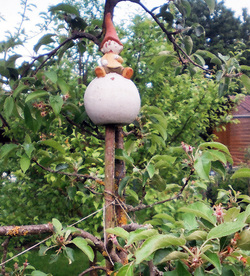
On the other end of perception Der Spiegel (“The Mirror”), the leading Newsweek-type magazine in Germany. Der Spiegel has Schrebergärten colonies pegged as “garden ghettoes.” *****
Germans have a museum for everything, so of course there is a Schrebergarten Museum. That’s in Leipzig. We’ll go there to track this green subculture back to four trends of the 1800s.
Germans have a museum for everything, so of course there is a Schrebergarten Museum. That’s in Leipzig. We’ll go there to track this green subculture back to four trends of the 1800s.
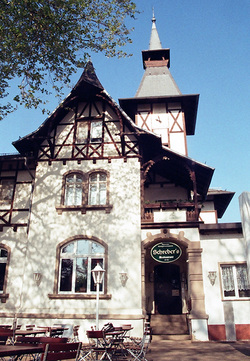 The Schrebergarten Museum
The Schrebergarten Museum Doktor Schreber we find in the Leipzig of early industrialization, the city dirty under a sky polluted, an urban hell, people corralled in apartments when not working their 12-hour shifts, their children growing up pale in that world of brick and cobblestone and soot. From today’s viewpoint it seems ever so obvious that this couldn’t be healthy, not for adults and especially not for kids, but in the mid-1800s it was a novel idea to create green space in and near the cities for the worker class. That is what Schreber prescribed.
In England, which was way ahead of Germany in industrialization, the need of urban green space had already been recognized, gardening grounds and parks the result. If Schreber took heed of the English example is not known. In any case he did write about the green-space need in the shape of a grassy playground.
But don’t think of the man in all-too-positive terms. As a pedagogue he rated “the fright of children,” according to a DVD we purchase at the museum. Schreber’s dictum: you can’t let plants grow naturally but you must prune them, and for the same reason children must be disciplined and given strict directions. Baby cries, smack it. Posture is important, so here are a number of exercises on machines designed by the Doktor himself. See to it that your children go through those exercises daily. Gehorsam is crucial: obedience at all times. When at the table, around the head a metal band protruding from a rod fixed onto the back of the chair, will assure your child sits upright at all times.
The not so funny thing is, three of Schreber’s own offspring suffered mental illness; one of his sons committed suicide after publishing a book about his paranoia.
On to Ernst Innocenz Hauschild. He was a teacher, a Schreber contemporary who founded the first Schreber Club after Schreber’s death, networking with a parents-teachers association.
OK, so now you have a large lawn with various structures for play and gymnastics.
Comes Karl Gsell who moved to Leipzig after retiring from teaching. He took a look at the green playground expanse and had the bright idea to turn the perimeter into vegetable beds so that children learn gardening. One little problem: the kids wanted to run and play instead of plucking weeds. So their parents came and did the gardening work. This is one strand from which the Schrebergärten developed.
In England, which was way ahead of Germany in industrialization, the need of urban green space had already been recognized, gardening grounds and parks the result. If Schreber took heed of the English example is not known. In any case he did write about the green-space need in the shape of a grassy playground.
But don’t think of the man in all-too-positive terms. As a pedagogue he rated “the fright of children,” according to a DVD we purchase at the museum. Schreber’s dictum: you can’t let plants grow naturally but you must prune them, and for the same reason children must be disciplined and given strict directions. Baby cries, smack it. Posture is important, so here are a number of exercises on machines designed by the Doktor himself. See to it that your children go through those exercises daily. Gehorsam is crucial: obedience at all times. When at the table, around the head a metal band protruding from a rod fixed onto the back of the chair, will assure your child sits upright at all times.
The not so funny thing is, three of Schreber’s own offspring suffered mental illness; one of his sons committed suicide after publishing a book about his paranoia.
On to Ernst Innocenz Hauschild. He was a teacher, a Schreber contemporary who founded the first Schreber Club after Schreber’s death, networking with a parents-teachers association.
OK, so now you have a large lawn with various structures for play and gymnastics.
Comes Karl Gsell who moved to Leipzig after retiring from teaching. He took a look at the green playground expanse and had the bright idea to turn the perimeter into vegetable beds so that children learn gardening. One little problem: the kids wanted to run and play instead of plucking weeds. So their parents came and did the gardening work. This is one strand from which the Schrebergärten developed.
The second strand is the Naturheilbewegung of the 1800s, the “Natural Health Movement” influenced by French philosopher Jacques Rousseau’s tenet: “Live naturally, be patient, chase the doctor away.” Of course there had to be clubs, the Naturheilvereine. Beginning around 1840, these alternative-medicine clubs established “air and light baths,” and then added water: swimming in the pools of creeks. In the 1890s those natural-health clubs started to merge with the Schrebergarten movement, in fact, a number of the Schrebergarten clubs today trace their origins to Naturheilvereine. A side shoot were Lebensreformer – “life reformer” – movements that promoted vegetarianism which dovetailed with fruit growing colonies.
The third strand, industrialists’ involvement: at some point they realized that a healthy workforce was more efficient and therefor more profitable, and so they purchased ground for Schrebergärten, a.k.a. Kleingärten, “small gardens.” The railroad Schrebergärten like Grau’s are a surviving example of that trend, originally intended only for folks working on the trains and tracks. Another famous example are the Schrebergarten grounds established by steel manufacturer Alfred Krupp, Der Kanonenkönig (“The Cannon King”) of Essen, in 1895. And the Red Cross also got in on the act with Schrebergärten for the poor and unemployed. In some of those holdings, children of the poor were given milk and bread at certain times.
The fourth strand, not so pretty. Anarchical. Street battles with police: by the 1870s, the apartment situation in the cities, particularly in Berlin, has become so tight and so expensive for workers that people take it upon themselves to start up colonies of small garden plots with thrown-together shelters for living at city’s edge. Basically they’re large slums-with-gardens, shanty towns similar to Brazil’s favelas.
This is described in great detail by Peter Warnecke in Laube Liebe Hoffnung, “Bower-Hut Love Hope” © 2001. He lets the numbers speak: at the beginning of the 19th century, Berlin had 150,000 residents; in 1852 there were 421,000, in 1871 the city had grown to 826,000, in 1895 to 2 million-plus, in 1910 a whopping 3,73 million were competing for apartments in Mietkasernen, “barracks for renters” five and six stories high. Warnecke cites an 1875 Berlin report that counts 28,238 apartments wherein 184,230 residents live; to afford the rents that were regularly increasing, many families took in Schlafburschen, “sleep boys” who paid for bed space during staggered periods of the day and night.
Apartment rental contracts ran only short-term, so that the landlord could rent to someone else for a higher price; this resulted in families who, “...twice a year – on April 1 and on October 1 – wandered about the city with all their belongings looking for a place to stay.”
Many of them ended up in the colonies at city edge, either squatting outright or renting a garden plot.
But most of the people who streamed into those colonies were new arrivals from rural areas, Warnecke writes.
Ah!, this is where Lentz’s story connects with the Schrebergärten, indirectly, in that it’s highly likely that some of her not-emigrated relatives of yore ended up in small garden shelters on city edge during early industrialization. For them the garden-with-shelter was a miniature farm removed from their erstwhile Dorf.
One photo in Warnecke’s book shows a large group of people, a few on horses, parading through a garden colony with a harvest festival wreath: “The first Kleingärtner called themselves Ackerbürger” – Acker, a “farmed field,” Bürger, a “city resident.” “As they made the transition from country to city, they continued their rural traditions.” Some of the young girls in the photo actually do look a bit like Lentz when she was a youngster...
The third strand, industrialists’ involvement: at some point they realized that a healthy workforce was more efficient and therefor more profitable, and so they purchased ground for Schrebergärten, a.k.a. Kleingärten, “small gardens.” The railroad Schrebergärten like Grau’s are a surviving example of that trend, originally intended only for folks working on the trains and tracks. Another famous example are the Schrebergarten grounds established by steel manufacturer Alfred Krupp, Der Kanonenkönig (“The Cannon King”) of Essen, in 1895. And the Red Cross also got in on the act with Schrebergärten for the poor and unemployed. In some of those holdings, children of the poor were given milk and bread at certain times.
The fourth strand, not so pretty. Anarchical. Street battles with police: by the 1870s, the apartment situation in the cities, particularly in Berlin, has become so tight and so expensive for workers that people take it upon themselves to start up colonies of small garden plots with thrown-together shelters for living at city’s edge. Basically they’re large slums-with-gardens, shanty towns similar to Brazil’s favelas.
This is described in great detail by Peter Warnecke in Laube Liebe Hoffnung, “Bower-Hut Love Hope” © 2001. He lets the numbers speak: at the beginning of the 19th century, Berlin had 150,000 residents; in 1852 there were 421,000, in 1871 the city had grown to 826,000, in 1895 to 2 million-plus, in 1910 a whopping 3,73 million were competing for apartments in Mietkasernen, “barracks for renters” five and six stories high. Warnecke cites an 1875 Berlin report that counts 28,238 apartments wherein 184,230 residents live; to afford the rents that were regularly increasing, many families took in Schlafburschen, “sleep boys” who paid for bed space during staggered periods of the day and night.
Apartment rental contracts ran only short-term, so that the landlord could rent to someone else for a higher price; this resulted in families who, “...twice a year – on April 1 and on October 1 – wandered about the city with all their belongings looking for a place to stay.”
Many of them ended up in the colonies at city edge, either squatting outright or renting a garden plot.
But most of the people who streamed into those colonies were new arrivals from rural areas, Warnecke writes.
Ah!, this is where Lentz’s story connects with the Schrebergärten, indirectly, in that it’s highly likely that some of her not-emigrated relatives of yore ended up in small garden shelters on city edge during early industrialization. For them the garden-with-shelter was a miniature farm removed from their erstwhile Dorf.
One photo in Warnecke’s book shows a large group of people, a few on horses, parading through a garden colony with a harvest festival wreath: “The first Kleingärtner called themselves Ackerbürger” – Acker, a “farmed field,” Bürger, a “city resident.” “As they made the transition from country to city, they continued their rural traditions.” Some of the young girls in the photo actually do look a bit like Lentz when she was a youngster...
*****
“Apartment Misery and Anarchic Self-Help, Civilization Fatigue and Civilian Charity,” so Warnecke headlines the four strands of the first period of garden colonies, from 1872 to 1918. Quite a checkered beginning.
In the new-arrivals’ colonies the garden rents were controlled by either a landlord or a “big-lessee” who made money renting plots. As the city apartment rents, garden rents were changeable and could be cancelled easily; typically they ran for one year only, which accounts for the absence of trees and shrubs in the earliest photographs of these colonies – nobody is going to plant trees if they have to leave again in 12 months. To protect themselves somewhat from exploitative landlords, the colonists formed associations to speak with one voice.
In any case the whole colony was on insecure ground because as the city expanded the land was needed for more rental barracks, for more factories. The colonies moved and moved again.
Once a colony became more stable, the city weighing in with rules and regulations and dictating to the landlords to establish longer-period rents, a busy rearing of small livestock materialized, chickens were raised and goats and, particularly, rabbits. In both World Wars the government called on Schrebergärtner/Kleingärtner to slaughter the rabbits so their fur could be used in clothing for the troops on the front.
In the new-arrivals’ colonies the garden rents were controlled by either a landlord or a “big-lessee” who made money renting plots. As the city apartment rents, garden rents were changeable and could be cancelled easily; typically they ran for one year only, which accounts for the absence of trees and shrubs in the earliest photographs of these colonies – nobody is going to plant trees if they have to leave again in 12 months. To protect themselves somewhat from exploitative landlords, the colonists formed associations to speak with one voice.
In any case the whole colony was on insecure ground because as the city expanded the land was needed for more rental barracks, for more factories. The colonies moved and moved again.
Once a colony became more stable, the city weighing in with rules and regulations and dictating to the landlords to establish longer-period rents, a busy rearing of small livestock materialized, chickens were raised and goats and, particularly, rabbits. In both World Wars the government called on Schrebergärtner/Kleingärtner to slaughter the rabbits so their fur could be used in clothing for the troops on the front.
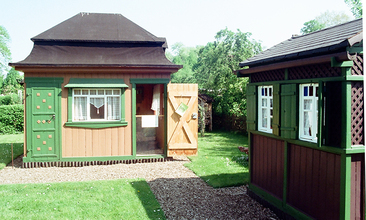
In their multitude the colonies represented a considerable food source. During the Third Reich the garden colony clubs were forced into a country-wide organization under Nazi control, so we have fairly accurate estimates of what these gardens produced: 87,247 tons of fruit and 227,734 tons of vegetables; livestock numbers were at 549,153 chickens, 389,769 rabbits, 11,873 bee hives, 5,934 goats, and 13,699 pigs. These stats were generated by a Nazi official in 1939, when 763,662 garden plots were counted across Germany.
Yes, during the later phases of the World Wars and immediately afterwards, the small-garden colonies were contributory for many folks getting through the hunger years.
In the post-World War Two Wirtschaftswunder (“Economic Miracle”) years, city, state, and federal governments began to regulate the Schrebergärten more and more. Today none of the garden huts can be used for year-round living, and most clubs no longer allow livestock of any kind.
Caterina Hildebrand, who has a degree in museology and manages the Schrebergarten Museum in Leipzig, tells us that recent trends in Schrebergarten clubs differ. In some areas, particularly those farther out from cities, membership is declining and some clubs are actually disbanding. But in other areas, Schrebergärten are thriving more than ever.
Yes, during the later phases of the World Wars and immediately afterwards, the small-garden colonies were contributory for many folks getting through the hunger years.
In the post-World War Two Wirtschaftswunder (“Economic Miracle”) years, city, state, and federal governments began to regulate the Schrebergärten more and more. Today none of the garden huts can be used for year-round living, and most clubs no longer allow livestock of any kind.
Caterina Hildebrand, who has a degree in museology and manages the Schrebergarten Museum in Leipzig, tells us that recent trends in Schrebergarten clubs differ. In some areas, particularly those farther out from cities, membership is declining and some clubs are actually disbanding. But in other areas, Schrebergärten are thriving more than ever.
*****
That’s certainly the case in Freimann. Jürgen Grau says that 36 people are currently on the waiting list to rent one of the 227 parcels. Schrebergärten are a great deal, he notes: “The lease, the membership fee, the fire insurance, and a little money for the perimeter upkeep, it adds up to only about €200 a year (about $300). If you bought a plot like this close to the city on private land, it’d cost you around €30,000.”
When he leased the garden in 2004 he paid the previous renter €3,700 for the hut and other improvements.
“The average age of the club members is over 60,” he remarks. “That’s because once you have a garden like this, you never give it up. When people are over 80 and can’t get around anymore, that’s when they let the lease go. Every year three to four gardens change hands, so there are always a few new people.”
When he leased the garden in 2004 he paid the previous renter €3,700 for the hut and other improvements.
“The average age of the club members is over 60,” he remarks. “That’s because once you have a garden like this, you never give it up. When people are over 80 and can’t get around anymore, that’s when they let the lease go. Every year three to four gardens change hands, so there are always a few new people.”
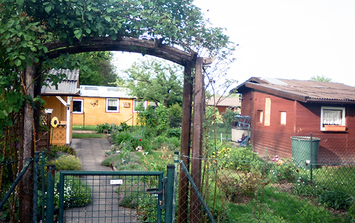
In the Leipzig museum many photos show a very active club life, dances and games at the central square, and parades, even amateur theater performed on stage. At Freimann the club’s not as social as that. “Once a year there is a membership meeting,” Grau relates. On the edge of the grounds stands a restaurant, also a club lease, it’s there that folks meet and socialize over beers, informally. He himself chats regularly with about 30 to 40 of his co-gardeners; he’s made a handful of good friends with whom he frequently gets together at his or their garden hut.
The club rules are punctilious, but acceptable, Grau explains, strictly under the umbrella of the Bundeskleingartengesetz, 108 pages of “Federal Small Garden Law.” The size and other aspects of the hut are prescribed. A minimum 10 square meters of garden must be in vegetables; a minimum 30 percent must be producing food stuffs. “When they last came to measure my garden, I was at 56 percent,” Grau says, proudly: he raises asparagus, green beans, zucchini, bell peppers, chives, tomatoes; and kohlrabi, onions, spuds, and of course pumpkins – in addition to the perennial berries and tree fruit.
Wife Gabi loves all the fresh veggies seasonally, she tells us when she arrives with the salad.
From the hut appear plates and silverware. We sit around the table and watch Grau finish his Grillen. The garden is a quiet and calm place, you sense folks in other gardens but the hedges muffle sound; loud parties are not allowed.
It’s a good meal in the fresh air, and good conversation about growing garden plants and cooking them. It’s the most relaxed German encounter Lentz has during her first visit to the Old Country.
The club rules are punctilious, but acceptable, Grau explains, strictly under the umbrella of the Bundeskleingartengesetz, 108 pages of “Federal Small Garden Law.” The size and other aspects of the hut are prescribed. A minimum 10 square meters of garden must be in vegetables; a minimum 30 percent must be producing food stuffs. “When they last came to measure my garden, I was at 56 percent,” Grau says, proudly: he raises asparagus, green beans, zucchini, bell peppers, chives, tomatoes; and kohlrabi, onions, spuds, and of course pumpkins – in addition to the perennial berries and tree fruit.
Wife Gabi loves all the fresh veggies seasonally, she tells us when she arrives with the salad.
From the hut appear plates and silverware. We sit around the table and watch Grau finish his Grillen. The garden is a quiet and calm place, you sense folks in other gardens but the hedges muffle sound; loud parties are not allowed.
It’s a good meal in the fresh air, and good conversation about growing garden plants and cooking them. It’s the most relaxed German encounter Lentz has during her first visit to the Old Country.
Can Lentz see herself having her own Schrebergarten? “Well, this garden was tiny but quaint, and the hut was a tiny, cute house. But I’d never live in a city, so I wouldn’t have a Schrebergarten.
“If I had to live in Germany I’d be one of those people in a Dorf.” She corrects herself: “At the edge of a Dorf. I’d have chickens and a dog, and a pony. Yes, for me that would be the only choice in Germany. I like things simple.”
*****
The Frankfurt Airport, anything but simple. When her plane lifts off Lentz looks down on the towns with their Schrebergärten on the edges, she sees the many Dörfer in between the checkerboard of fields and woods. She’s gained an understanding of the country and its people, and its terrible history her forebears experienced.
Then the plane flies above clouds, Seattle-bound.
And we’re off to the Russia of Catherine the Great.
© 2015 Lentz Spelt Farms
“If I had to live in Germany I’d be one of those people in a Dorf.” She corrects herself: “At the edge of a Dorf. I’d have chickens and a dog, and a pony. Yes, for me that would be the only choice in Germany. I like things simple.”
*****
The Frankfurt Airport, anything but simple. When her plane lifts off Lentz looks down on the towns with their Schrebergärten on the edges, she sees the many Dörfer in between the checkerboard of fields and woods. She’s gained an understanding of the country and its people, and its terrible history her forebears experienced.
Then the plane flies above clouds, Seattle-bound.
And we’re off to the Russia of Catherine the Great.
© 2015 Lentz Spelt Farms


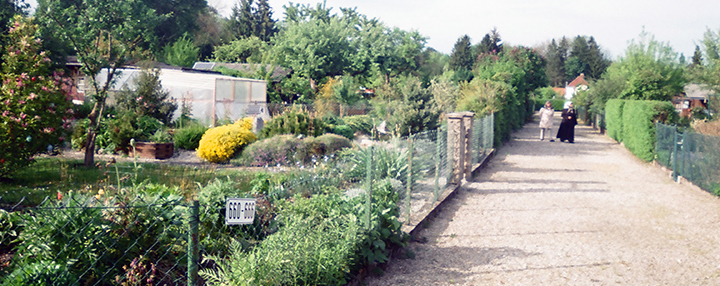

 RSS Feed
RSS Feed